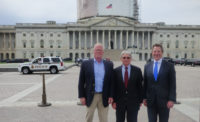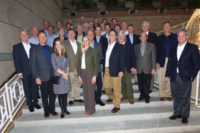Your voice means something in Washington

Representatives from Eastern Industrial Supplies and Apollo Valves with South Carolina Senator Lindsey Graham during ASA’s Legislative Fly-in in Washington. Photo by Mike Miazga/Supply House Times.
What’s the best way you process information? Some people digest information more effectively through reading printed material, books, etc., while others retain more information through face-to-face interactions. I skew toward the printed material/books spectrum of the scale.
Politicians, on the other hand, tend to go the face-to-face interaction route. That was a key takeaway from the American Supply Association’s recent Legislative Fly-In event in Washington, D.C.
During the association’s legislative briefing the day before we went on Capitol Hill to visit with elected officials, ASA Director of Government Affairs Dan Hilton, as he wonderfully does at these events, spoke to attendees on what to expect during the visits, while also going through the key issues that ASA members planned on discussing with their elected officials.
According to data from a Congressional Management Foundation study, when congressional staff were asked what advocacy factors influence an “undecided” lawmaker, 94% said “in-person issue visits from constituents” would have some or a lot of influence and 92% said “individualized email messages” from constituents would.
That was far from the only eye-opening number that struck me during the two days in Washington. A topic that has been talked about plenty in the industry of late is the labor shortage, which was one of the key talking points during these Hill visits. ASA data shows less than 4% of the industry’s workforce is under the age of 26 and by the year 2025 nearly 50,000 employees in plumbing and PVF distribution will have retired, which brings to the forefront the critical need to find and train qualified replacements.
ASA members asked their elected officials to pass the Strengthening Career & Technical Education for the 21st Century Act, which reforms programs needed to develop the next generation of workers required to meet the demands in the distribution, manufacturing, construction and plumbing industry.
“Half our workforce is aging out,” McGuire Mfg. President Bob Williams told a staffer from Connecticut Congresswoman Elizabeth Esty’s office. “There is a major labor shortage in the industry and in all the trades. It’s not going away and it’s something that needs to be addressed. A person can make an honest and fair living in our industry.”
The good news on that front is the House, in mid-June, backed the bill, which will give more decision-making and funding authority to states.
We also heard during the briefing from IAPMO Senior Vice President of Government Affairs Dain Hansen who spoke about a number of topics related to water conservation and water infrastructure, as well as the hot-button topic of the possible discontinuation of the WaterSense labeling program by the Trump administration. Hansen pointed out the program costs $3 million to administer each year, yet has saved more than 1 trillion gal. of water since 2006.
On the water infrastructure front, ASA shared an item that the U.S. Conference of Mayors found, on average, municipalities spend between 6 and 7 cents of every tax dollar on water and sewer systems. Water infrastructure, ASA noted, is the third-largest expense for cities after education and emergency personnel. Fly-In attendees encouraged their elected officials to support the Safe Drinking Water Act and Federal Water Pollution Control Act.
Other topics on the agenda during this trip to Capitol Hill included tax reform, health care and the continued push for marketplace fairness concerning internet sales tax. From the visits I made with ASA members, some sort of tax reform could be categorized as optimistic, while health care is another issue.
I’ve said this before and I’ll say it again. If you have never participated in a Congressional fly-in, what are you waiting for? These elected officials do want to hear from you.
You saw the statistic above: 94% of lawmakers undecided about an issue view an in-person visit as having some or a lot of influence. And if you can’t go to Washington, meet with that elected official at their home district office or invite them to your facility for a tour.
Make your voice heard. Our industry will be better off because of it.
This article was originally titled “Use your voice” in the July2017 print edition of Supply House Times.
Looking for a reprint of this article?
From high-res PDFs to custom plaques, order your copy today!









